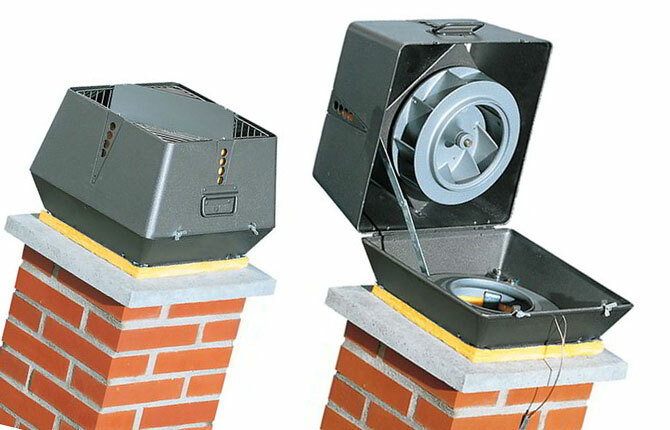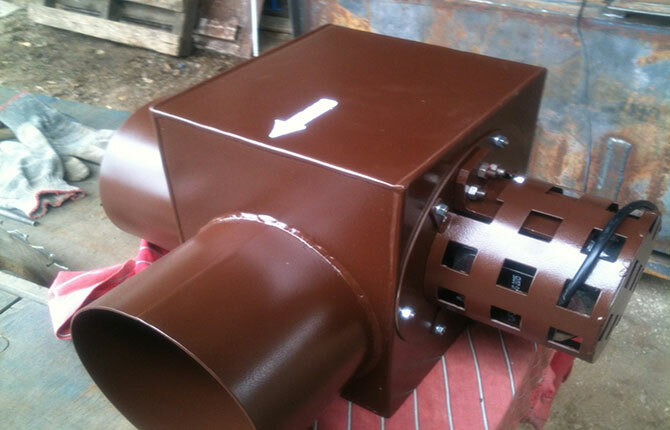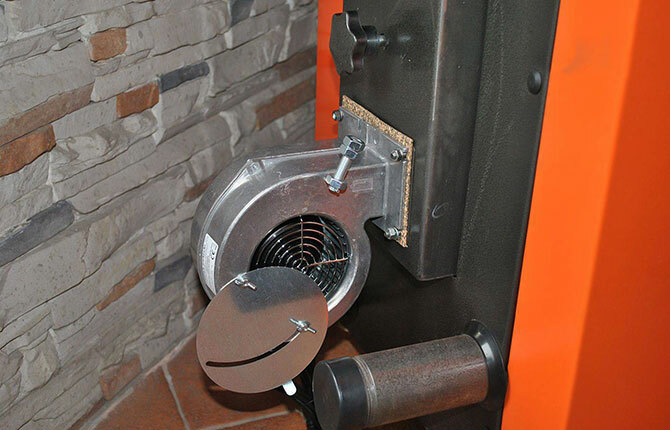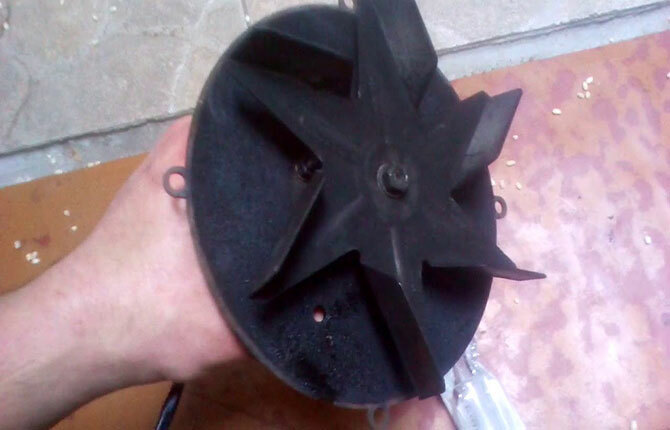Smoke exhausters for boilers resemble fans. They are even structurally similar. You can distinguish between both equipment options by marking. For fans, the brand begins with the letter "B", for smoke exhausters with the letter "D". At the same time, the latter are made of heat-resistant steel, which increases their cost.
The content of the article:
- The purpose of the smoke exhaust device
- Design and principle of operation
- Specifications and calculation of parameters
-
Varieties
- Natural draft boosters
- Flow-through smoke exhausters for boilers
- Centrifugal duct smoke exhausters for solid fuel boilers
- Pros and cons
-
Features of choice
- Rule #1
- Rule #2
- Rule #3
- Rule #4
- Rule #5
- Other selection criteria
- Mounting Features
- Maintenance and operation
- Technology and recommendations for self-production
The purpose of the smoke exhaust device
The main task of the smoke exhauster is to remove carbon monoxide gases, which are formed during the combustion of fuel inside the combustion chamber. boiler. The equipment is installed after the last, crashing into the chimney. Place of installation - indoors or outdoors.
In the model line of equipment there are smoke exhausters used in fire fighting systems. Their task is to remove smoke from the premises, toxic substances, fire extinguishing powders, gases, aerosols, and lower the temperature.

Design and principle of operation
Structurally, the smoke exhauster of a domestic or industrial boiler consists of:
- steel case;
- impellers, it is also an impeller;
- shaft on which the impeller is mounted;
- electric motor;
- support frame.
The body is a welded structure consisting of a shell made in the form of a volute and two sidewalls. In the center of one sidewall there is a hole for the inlet pipe. Through it, exhaust gases are sucked in. The cross section of the hole corresponds to the performance of the smoke exhauster.
There is also a hole in the center of the second sidewall through which the shaft of the device passes. The snail ends with a branch pipe through which gases are removed from the boiler. The cross section is usually square.
There are several versions of smoke exhausters:
- The impeller is mounted on a shaft, which is connected to the motor shaft by a coupling or belt drive through pulleys. The first is installed in two bearings.
- The impeller is mounted on the motor shaft. This model is more compact.
- The snail relative to the frame can be rotated at a certain angle in accordance with GOST.
- The rotation of the impeller can be right or left.
The principle of operation of boiler smoke exhausters is identical to that of centrifugal fans. It is important here to create a vacuum, that is, to reduce the pressure inside the combustion chamber. Due to this, air and gases move from outside to the furnace and from the latter to the chimney. Air enters the furnace, supports the combustion of fuel. Exhaust gases and smoke move to the chimney of the boiler and are brought out through it.
Inside the smoke exhauster, air masses move from the inlet located in the center to the center of the impeller (using centrifugal force). After the blades of the impeller are thrown to the inner surface of the volute and removed through the inlet pipe.

Specifications and calculation of parameters
When choosing a smoke exhauster for solid fuel and other types of boilers, three technical characteristics are taken into account:
- equipment performance;
- pressure created to move gases;
- motor power.
It is necessary to take into account the fact that the choice is made towards a smoke exhaust unit, the performance of which exceeds the operating conditions of the boiler.
Calculations of the parameters of the smoke exhauster are based on the technical characteristics of the boiler, such as:
- performance;
- fuel consumption;
- the amount of air required to burn the fuel;
- the amount of gases formed during the combustion of fuel and air oxidation;
- heat of combustion of fuel.
All these parameters are in the boiler passport. Based on them, the performance of the smoke exhauster is determined from the tables. And so is his brand.
Varieties
Smoke exhausters do not have a wide model line. There are two groups:
- for boilers;
- used for fire fighting purposes.
The first group includes two models:
- Labeled "D". This is the simplest and most reliable equipment, in which the blades on the impeller are tilted forward.
- Under the brand "DN". These are industrial type smoke exhaust units with blades pointing backwards.
An important criterion for increasing the thrust in the boiler is the type of fuel used. The more by-products the fuel emits during combustion, the stronger the draft should be at the boiler. Therefore, centrifugal smoke exhausters are installed on solid fuel boilers. For gas, a flow option or a traction booster is suitable. The same applies to pyrolysis boilers.
Natural draft boosters
The simplest device in this category is a unit equipped with an axial fan. It is simply placed at the end of the chimney and connected to an electrical network with a voltage of 220 volts. A visor is mounted on top to protect the amplifier from rain and snow.
The performance of the devices is regulated manually or using a control unit that is installed inside the house. Often both items are included. But more often the fan and the block have to be bought separately.
Flow-through smoke exhausters for boilers
By design, this is a pure smoke exhaust installation - a housing inside which an impeller is installed, mounted on an electric motor shaft. But the method of mounting the device is different from the classic models.
The impeller of the unit is installed so that it, together with the body, becomes a continuation of the chimney. At the same time, the impeller does not reduce the cross section of the pipe in any way. The electric motor is located outside the chimney structure.
Often, for flow models, a separate chimney is erected, which is built parallel to the main one. That is, the chimney system of the boiler consists of two pipes. One constantly works on natural draft, the second with the help of a smoke exhauster. The convenience of the option lies in the fact that when the power is turned off, which often happens in country houses, traction will always be present due to the main pipe.

Centrifugal duct smoke exhausters for solid fuel boilers
For solid and liquid fuel boilers, there is no better option. This applies to both domestic and industrial boilers. This type of equipment works effectively if it is tied to the boiler control unit. It will independently react to all changes in the fuel combustion process, if necessary, quickly change its parameters.
Centrifugal models well create a vacuum in the furnace and high pressure inside the chimney, on which the draft depends.
Pros and cons
There are four advantages, only on the basis of which it is possible to install a smoke exhauster on the boiler:
- Reduced fuel consumption.
- Increasing the efficiency of the boiler.
- The chimney is not clogged - soot does not collect on its inner walls.
- The smell of burnt fuel, and even more so its unburned part, will never penetrate inside the rooms.
All these advantages do not depend on the weather. And in snow, and in rain, and in strong wind, the boiler will work efficiently.
There are also disadvantages:
- Smoke exhauster - additional costs.
- It is better to entrust its installation to specialists. And that's another expense.
- Sometimes you have to pay for repairs and maintenance.
Features of choice
Before choosing a smoke exhauster for a boiler, it is recommended that you familiarize yourself with the five selection rules.
Rule #1
It is better to choose a model that has the ability to adjust. Manufacturers offer three options in this regard:
- standard devices connected to the electrical network and having only the “on-off” function;
- connected to the automation of a solid fuel boiler;
- with thermostats.
The latter belong specifically to the category of "the best smoke exhauster in terms of functionality." The device is connected to the electrical network. It displays the temperature. Low draft of the boiler is formed at temperatures from +50 ℃ to +140 ℃. As soon as the temperature inside the chimney drops to a predetermined value, the smoke exhauster immediately turns on, increasing the draft of the boiler.
Rule #2
The smoke exhaust unit for the boiler must withstand a temperature of at least +250 ℃. This parameter is indicated by the manufacturer in the product data sheet. In this case, you should always pay attention to the performance of the device.
The high power of the smoke exhauster, much higher than the parameters of the boiler, reduces the technical characteristics of the latter:
- efficiency decreases;
- fuel consumption increases due to rapid burnout;
- frequent boiling of boilers;
- condensate is formed in the chimney, which adversely affects the technical condition of the chimney system;
- there are strong drafts in the house.
Rule #3
Low performance is also a minus. Therefore, it is recommended to choose units with a capacity of at least 500 m³/h. Otherwise, the efficiency of the equipment will decrease. This is especially true for solid fuel boilers, the fuel of which does not burn completely.
Non-combustible particles will settle on the walls of the heat exchangers and the chimney, reducing the efficiency of the entire heating system.
Rule #4
The chimney fan should not greatly affect the natural draft of the boiler. This device is just an assistant, and not the main element that creates traction. Therefore, it is important to first accurately calculate the performance, and then purchase the unit.
Another point related to power supply - all smoke exhaust models are powered by electricity, which is not always present in suburban villages. And if there are no problems with flow, then there will definitely be problems with traction amplifiers and centrifugal structures. Therefore, it is recommended to buy an additional uninterruptible power supply (UPS) for them.
Rule #5
If there is a choice of purchasing an outdoor installation option or an indoor one, then it is better to give preference to the first one. Both options are structurally different from each other. The difference is only in performance and degree of protection. Outdoor models can be installed inside the house, but indoor models cannot be mounted on the streets.
If you install an additional visor above the smoke exhauster, it will extend the life of the device. Outdoor structures easily withstand temperatures from -30 ℃.
Units for indoor installation are not always easy to install. Inside the house, the chimney pipe is short, hence the complexity of installation.

Other selection criteria
A few tips from the experts:
- smoke exhausters for stainless steel boilers in priority;
- if you bought a device made of carbon steel, then the thickness of the walls of the case should not be less than 2 mm, and the impeller should be made of stainless steel;
- galvanized products in the design of the smoke exhaust unit for boilers should not be present.
Mounting Features
The most common smoke exhausters that are used for household boilers are flow-through or, in other words, overhead models. They are simply cut into the chimney without dismantling it.
First, you need to choose the right device. There are many criteria: performance, the amount of gases removed, and so on. But it is easier to make a selection according to the diameter of the chimney. This parameter must match the diameter of the pipes of the smoke exhaust structure.
Further, everything is simple:
- a marking is applied to the pipe according to the template;
- a grinder makes a cut along the drawn lines;
- a rectangular hole is obtained;
- its edges are coated with silicone sealant;
- a smoke exhauster is installed, which is attached to the pipe with two clamps.
If the chimney of the boiler is a sandwich structure, then first a rectangle of the outer pipe is cut out, then the heat-insulating material is removed, then the rectangle of the inner pipe is cut out. Next, the installation of the unit is carried out.
Draft amplifiers, they are channel smoke exhausters, are installed differently. Since their location is inside the chimney, part of the latter has to be removed, and the device should be installed in its place. This is not always easy, therefore it is recommended to mount boiler draft amplifiers at the end of the chimney structure, closing it with a visor. So, you need to choose only the street option.
Smoke exhausters for gas and other boilers can be installed on vertical and horizontal sections of the chimney. The exception is street models. They are mounted only on vertical pipes.
With horizontal installation, the device must be installed so that its electric motor is located on top - above the chimney. This protects the motor from the ingress of condensate and debris into it.
It is impossible to narrow the chimney pipe after the smoke exhauster. You can expand a little, but not much.
If the unit is mounted inside the house, then after it there must be a section of the chimney with a length of at least 1 m without bends, tees and other obstacles. In this section, there is an acceleration of the output of carbon monoxide from the boiler.
The closer the exhaust fan is to the boiler, the more efficient it works.
When you first turn it on, you need to pay attention to which direction the impeller rotates. The design must not be allowed to drive air into the boiler.
Maintenance and operation
The internal surfaces of the smoke exhauster are covered with soot during operation. It should be cleaned several times a year, at least once. This is especially true for the impeller blades. It's not that hard to do.
The blades are mounted at an angle. You just need to reconnect the smoke exhauster so that its shaft begins to rotate in the opposite direction. This movement creates a vacuum inside the chamber, causing the soot to begin to flake off. A few minutes of rotation will make the blades clean.

Technology and recommendations for self-production
Any technical device can be made by hand if the necessary blocks, parts and materials are available. In the case of a smoke exhauster for a boiler, this is an impeller with an electric motor. This block may be used. The key here is balance. The motor shaft must not have play. If this is present, then the exhauster will smash to pieces the first time you turn it on.
The second is the body. It is easy to make if you have welding skills. Making a snail is easy. The main thing is to follow the drawing and diagram. They are freely available. There are also unit dimensions. The only thing to consider is the thickness of the sheet metal used. This parameter should not be less than 2 mm, but not more than 5 mm. Thick material will make the structure heavier.
Finished blocks are interconnected. After that, they are installed on a previously prepared frame support. Fastening is made with bolts and nuts.
In all this operation, it will be difficult to accurately maintain the dimensions of the smoke exhauster. Even small downward deviations will lead to incorrect operation of the unit. Therefore, it is recommended to buy such a device necessary for boilers in a store. In this case, the equipment must have a quality certificate.
smoke exhauster - a unit that enhances the draft of the boiler. Therefore, the device is now more popular than ever. The main thing is to choose the right one for performance so as not to reduce the efficiency of boiler equipment. It has a large number of advantages, one of which is simple installation. Any costs associated with its operation are covered by the good performance of the boilers.
Choosing a smoke exhauster for a boiler, fireplace and stove: video.
Did you know about such nuances of choosing smoke exhausters for boilers? Tell in the comments. Bookmark the article so that useful information is always at hand.


